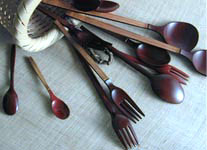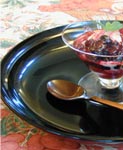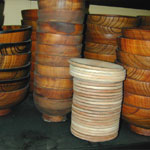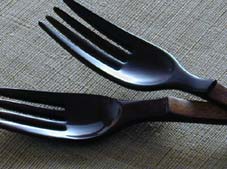
|
| Fushimi
Maki's Bamboo and Urushi Lacquer Works I found urushi lacquer ware that were"a natural beauty" with little "make-up"
When
I saw his works for the first time, it was so refreshing; the first
word that came to my mind was “a natural beauty”. I was surprised
to find someone who could work with lacquer so lightheartedly. Lacquer
is not thickly “caked on” or heavily applied. His urushi lacquer
works are divine unembellished wares. They are “natural beauty”,
wearing just little make up. |
|
Most
of Fushimi’s creations are beautiful bowls, plates, and trays. The
wooden cores are made with the turnery method, which are then applied
with several coatings of lacquer undercoat, followed by a final coat.
His vessels are shaped in classical, traditional forms, nevertheless, the artist’s personality and playfulness is reflected in each of his pieces. The works have a simplicity that puts in step with modern aesthetics. The “lack of austerity” in his works is what makes them special -- the warmth and subtleness, welcomes any style of cooking transforming the dinner table into something with much grace. |
|||
|
In this feature, I will introduce a work that has been carefully coated with undercoating or clay-like primer, then coated couple of times, finished with the final or third coating using the finest Japanese lacquer. The natural beauty of the wood grain can be seen through the transparent lacquer. The wood almost looks as if it is still breathing. Each piece is a refreshing piece of art, although they are made for use in every day life, respecting the wood’s natural expression and personality.(photo2)
|
|
|
Since the ancient times, multifold of lacquer was used as a means to provide a sealing and highly protective coating, making the wood very durable and functional. He believes, if his urushi lacquer works is to last for a lifetime, his relationship with the user should be a lifetime one as well. If the lacquer ware is damaged, he will always be available to his customers, and he will continue to mend and restore by applying lacquer. This, in fact, is the traditional way in which a relationship is established between the users and the craftsmen. If the material is fine, the work is fine, too How he creates such “natural beauties” is explained in the choices he makes in the lacquer he uses. Lacquer collection is far too labor intensive, and there are less and less people capable to tap lacquer trees for sap in the deep mountain forests, and consequently, Japanese lacquer has become expensive. Today the most commonly used lacquer comes from China. These reasonably priced lacquer is often mixed with cashew, and oil is added to obtain a finish with higher gloss. When Oide Akira, one of his young friends, showed Fushimi his 100 percent pure lacquer collected from the mountains in Nagano Prefecture, Fushimi’s thoughts and choice in the lacquer to use, changed. Below is an essay written by Fushimi, explaining why he decided using the fine Japanese lacquer. The expression “sara-sara” (thin) is not often heard in this profession, but hopefully his choice of words and expressions will covey his heart. |

|
I often used to tell myself, “Oide’s lacquer is one of the finest, so precious, that I shouldn’t put to waste by using it so frequently.” As an alternative, I used lacquer from China, trying to make it have the same consistency as the Japanese lacquer. Oide’s lacquer, was stored and used only for my “major art works”. Soon, however, I found myself questioning whether I was making a mistake. A year has already passed since I decided to use the “special” lacquer for all my works--works I am engrossed in everyday and my mind is cleared from all doubts. What is so special about Oide’s lacquer is that it has an incredible consistency like water, so thin and “sara sara”. There is undeniable difference in the degree of viscosity compared to lacquer from China. When lacquer is left to stand, it gradually becomes sticky. There is no greater joy in finding and being able to work with lacquer that continues to remains thin (sara-sara). The thin layers of lacquer enhance the natural beauty of the wood retaining the beautiful grain and texture of the wood. The lacquer dries or more accurately, cures. When it is thickly applied, it becomes very solid and strong. However, I feel heavy coating looses the wood’s natural expression and characteristics and becomes similar to any solid plastic. Lacquer is applied on wood ware to act as reinforcement. It may require repeated repair, and reinforcement, but it enables the ware to be used until the wood decays. Urushi lacquer ware is made from wood, and can not be compared with the firmness of a metal or a ceramic ware. For me, there is unmatched warmth and softness found in wooden ware. Oide’s lacquer has changed my thoughts about “applying lacquer”. Not only has it changed my choice in the lacquer to use, moreover, it has allowed me to find more joy in using the medium. (“Winds from the Studio”, 1996) |
|
|
|





